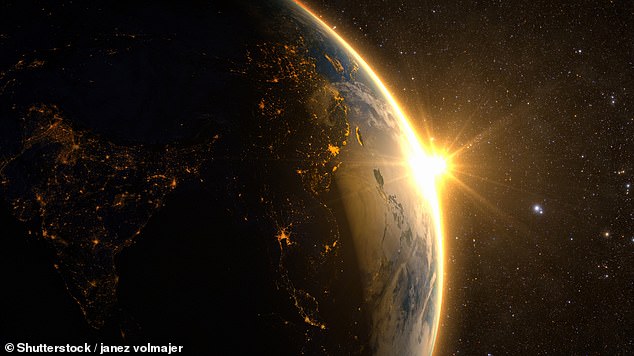If you’ve been feeling like the days are feeling longer than usual lately, scientists say you may not be alone.
Researchers at ETH Zurich have revealed that climate change is causing the length of days on Earth to increase at an “unprecedented” rate.
As polar ice melts in Greenland and Antarctica, Earth’s center of gravity shifts toward the equator, gradually slowing the planet’s rotation.
If emissions levels are not reduced, researchers predict this change could add 2.62 milliseconds per day by the end of 2100, an impact greater than that of the Moon.
While the effects won’t be noticeable to most humans, researchers say the subtle changes could wreak havoc on space travel.
Scientists have revealed that Earth’s days are lengthening at an “unprecedented rate” due to climate change
While it may seem strange that humans could have an effect on something as inevitable as the passing of the day, the physics is actually quite simple.
As man-made climate change causes global ocean temperatures to rise, meltwater flows from the polar ice caps toward the equator.
Co-lead author Benedikt Soja from ETH Zurich explains: ‘It’s like when a figure skater does a pirouette, first keeping the arms close to the body and then stretching them out.
‘The initially rapid rotation becomes slower because the masses move away from the axis of rotation, increasing the physical inertia.’
As the Earth’s rotation slows, the time it takes to spin on its axis increases and days become subtly longer than the standard 86,400 seconds.
This is not the only thing that can cause changes in the Earth’s rotation, as the planet’s speed is also affected by the Moon’s pull and conditions in the inner layers.

As polar sea ice in Antarctica (pictured) and Greenland melts, fresh water travels to the equator, where it upsets the Earth’s balance and slows the planet’s rotation.
However, in two recent papers, researchers have managed to tease apart the different impacts of each of these factors.
For most of Earth’s history, the biggest factor influencing day length has been “tidal friction” caused by the Moon’s gravity pulling on the ocean.
Tidal friction has added about 2.4 milliseconds to the length of the day every century over millions of years.
Researchers estimate that since 1990, water displacement due to climate change has added 0.8 milliseconds per day.
However, in a high-emissions scenario where greenhouse gas emissions are not reduced, researchers predict the rate of change could double by 2100.

While humans might not feel the effects, space missions like NASA’s Ingenuity probe (pictured) might not reach their targets as the planet’s rotation changes.
By the end of the century, climate change could add more than 2.62 milliseconds per century, making it the single most important factor in altering day length.
These effects will be so subtle that humans won’t be able to notice the change over a single lifetime, but researchers warn this could still have a major impact on space travel.
Dr Soja says: “Although the Earth’s rotation changes only slowly, this effect must be taken into account when navigating in space, for example when sending a space probe to land on another planet.”
In the vast distances of space covered by planetary probes like NASA’s Perseverance and Ingenuity, a deviation of just a centimeter on Earth could mean missing the target by hundreds of meters.
This is especially key for precision landings that aim to touch down at very specific points on distant planets.
Scientists will need to accurately estimate the exact course of Earth’s rotation for future space missions.

As the Earth’s liquid metal outer core shifts, this causes the Earth to wobble slightly on its axis in an effect known as polar motion.

The researchers used precise measurements to separate the effects of core dynamics from the effects of changes in the Earth’s surface on the planet’s polar motion.

Researchers believe climate change could be affecting conditions in Earth’s inner core, causing the shift in the rotation axis illustrated by the blue line in this graphic.
Dr Soja adds: “Otherwise, it will not be possible to land in a specific crater on Mars.”
In addition to changing the speed of Earth’s rotation, researchers also found that climate change could be tilting the planet on its axis.
The scientists used a technique called very long baseline interferometry, which measures how long it takes for radio signals to reach Earth from space.
This allowed them to take very precise measurements of the Earth’s “polar motion,” the change in the spin axis relative to the Earth’s surface.
They found that changes in polar motion are jointly affected by a combination of changes at the surface and changes deep within Earth’s liquid metal outer core.
As mass moves within the Earth under the intense pressure of the outer layers, this tilts the planet slightly on its axis.
Changes in water at the surface have a similar effect, but researchers also made the surprising discovery that climate change could be affecting conditions deep within the Earth.
Dr Soja says: ‘Climate change is causing the Earth’s rotational axis to shift, and it appears that the feedback from conservation of angular momentum is also changing the dynamics of the Earth’s core.’
Their researchers found that this feedback effect could cause changes in the Earth’s tilt over time.
However, they are unlikely to have serious or noticeable effects on the surface.
Co-lead author Dr Diani Shahvandi from ETH Zurich adds: “Current climate change could therefore be affecting even deep processes in the Earth’s interior and be more far-reaching than previously assumed.”

